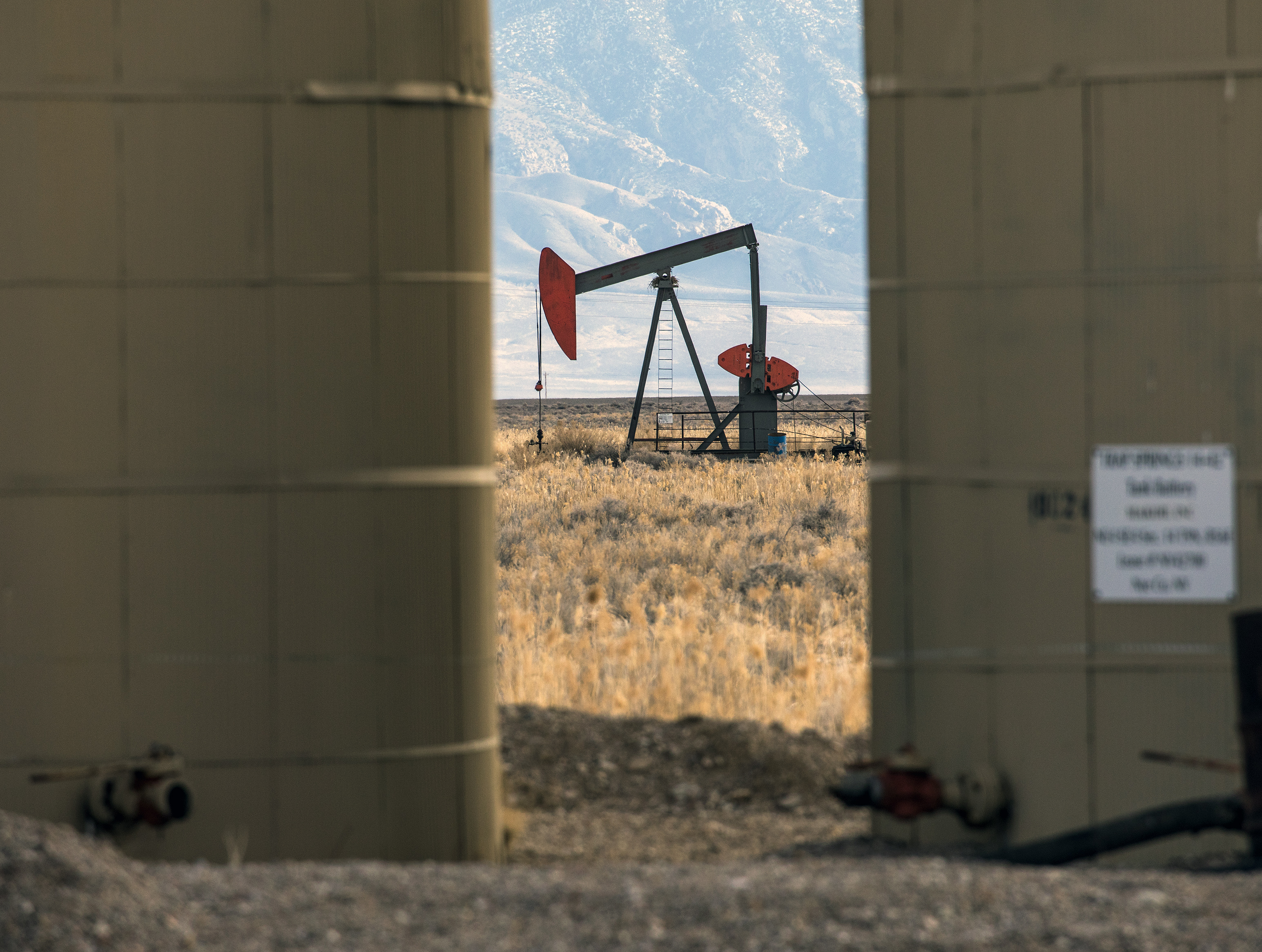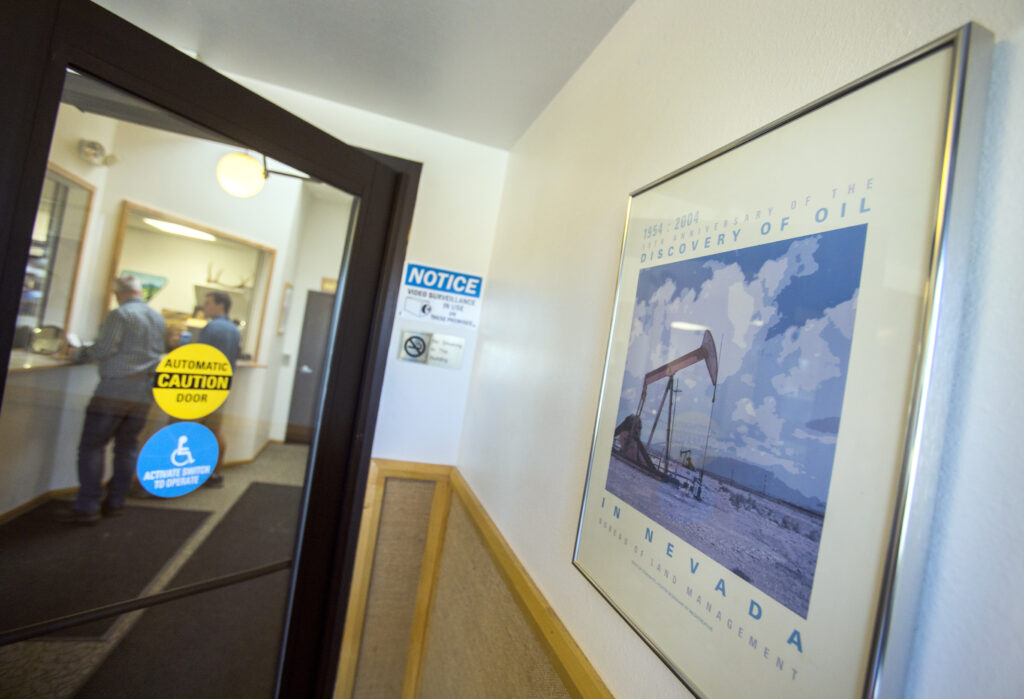A federal climate bill promised to fix oil leasing. But are the reforms being implemented?

Despite its reputation as the largest climate bill ever enacted in the United States, the Inflation Reduction Act passed last year did not trigger an end to leasing federal public land to drill for fossil fuels, as some environmental groups had advocated for.
The legislation did, however, tighten the rules for oil and gas leasing. It implemented reforms to a process that has long benefited the fossil fuel industry, especially in Nevada where there is rampant speculative leasing in which companies lease public land but fail to develop the parcels, preventing the land from being managed for other interests, including for conservation.
Or at least that was the intent. Although the law is meant to clamp down on speculative leasing, an upcoming lease sale in Nevada has several environmental groups concerned the U.S. Bureau of Land Management, which oversees federal land, is shirking the required reforms.
To nominate land for oil and gas leasing, an individual or a company must propose parcels by submitting an “expression of interest” to federal land managers. Before the Inflation Reduction Act, parcels could be nominated by anyone anonymously and for free. Now, nominators must disclose who they are and pay a $5 nonrefundable fee to file their expression of interest.
In November, an internal U.S. Bureau of Land Management memorandum provided more detail for how the new oil and gas reforms should be enforced by employees. It recommended federal land managers reject all nominations that are over three years old or submitted anonymously.
But in Nevada, 31 of the 35 land parcels — a total of roughly 63,000 acres — being considered for a lease sale in July meet that criteria for rejection, according to an analysis from the Center for Western Priorities, a conservation advocacy organization. Some environmental groups see the July lease sale as a test of how the administration implements the reforms across the region.
And it comes at a time when federal land managers are looking to strengthen protections for public land. Earlier this week, the Bureau of Land Management announced it was accepting public comment on a proposed rule that environmentalists said would better balance restoration and conservation with fossil fuel extraction and energy development, environmentalists said.
“What we've found is that in Nevada, 89 percent of the 63,000 acres that they are preparing to lease off were nominated more than three years ago,” said Aaron Weiss, deputy director of the Center for Western Priorities. “[This land] shouldn’t even be up for consideration.”

Another complicating factor under examination by the Center for Western Priorities is an Inflation Reduction Act provision that ties oil and gas leasing to renewable energy development.
Section 50265 of the act mandates a certain number of acres be made available for onshore oil and gas leasing before wind and solar energy development can be approved on federal land. The total number of acres offered for onshore lease sales cannot be less than 2 million acres or 50 percent of the total acreage of nominations received in a one-year period, whichever is less.
This provision was included to get all 50 Democratic senators to vote on the bill, including Sen. Joe Manchin (D-WV), a centrist with ties to the fossil fuel industry, InsideClimateNews reported.
“It’s sort of an additional hoop that the Bureau of Land Management has to jump through before they can issue the rights for wind and solar projects,” said Romany Webb, deputy director of the Sabin Center for Climate Change Law at Columbia University. “In that respect, [the provision] does have the potential to sort of slow down … and add some complexity to the process.”
As renewable energy in Nevada picks up speed, it’s unknown exactly how the provision will affect the timeline of solar or wind projects now that they are tied to oil and gas development. The effect of this provision will become clearer the longer renewable energy developers operate under the new rules outlined in the Inflation Reduction Act, according to Webb.
What environmentalists are more concerned with is whether public land in Nevada is being made available to the oil industry simply in order to meet the minimum number of acres that need to be available before renewable energy projects can be permitted.
Since the new reforms were enacted, an average of 21,000 acres per month have been nominated for oil leasing across the U.S., according to the Center for Western Priorities’ analysis.
This number is far below the minimum 2 million acres the Inflation Reduction Act provision recommends. That means federal land managers are likely to issue solar and wind permits after 50 percent — not 2 million — of the total acres nominated for oil are made available in one year.
Some question why so much land is offered for leasing in Nevada to begin with. Nevada is in the bottom five of the 32 oil-producing states in the country, according to data from the U.S. Energy Information Administration, yet it remains the focus of speculative leasing activities.
Prior to recent oil and gas reforms, speculative leasing occurred when members of the public nominated land anonymously but did not bid on that land during a competitive auction period. Once the auction was over, federal land managers opened up any unsold land to buyers on a first-come, first-served basis, issuing what federal officials call “noncompetitive leases.”
For these leases, the minimum bid price per acre was waived, and buyers only had to pay administrative fees and the parcel’s first-month’s rent, $1.50 per acre. This meant interested parties could nominate land with low oil potential, knowing it likely would not sell during the competitive auction period, then lease the land at a lower price, holding it up for other uses.
“The actors that you had in Nevada nominating these public lands were mostly speculators who would pick up a lease, try and hopefully sell it off to someone else to pad some oil and gas company’s books,” Weiss said, “even though they knew full well that that land was never going to produce oil and gas, certainly not at a cost that was effective to actually bring it to market.”
Even if leased land is never developed for oil production, federal officials can be prevented from managing it for other interests, such as recreation or wildlife. Conservationists and other public land users have noted that leases are valid for 10 years, meaning these public lands can go at least a decade without active management, and possibly more, if the leases are renewed.
“When an acre is under lease, the American public effectively loses some measure of control over the land that it owns, and the BLM cannot actively manage it for other valuable uses, including renewable energy, outdoor recreation, or conservation,” reads a 2019 report from the progressive think tank Center for American Progress, which has tracked the issue.

Between 2012 and 2020, 66 percent of noncompetitive leases issued in Colorado, Montana, Nevada, Utah, and Wyoming were for land with low development potential for oil and gas, according to the National Wildlife Federation. The Inflation Reduction Act sought to fix that.
It rescinded the Bureau of Land Management’s ability to issue noncompetitive leases. It also instituted a $5 nonrefundable filing fee, ending the anonymous filing system for expressions of interest. Minimum bidding on parcels now starts at $10 an acre, up from $2.
But so far, these reforms have appeared to result in few changes to how much or what land can be leased, according to environmental groups monitoring oil and gas sales.
“These reforms don’t functionally reform the nomination process … you can still nominate all sorts of land,” said Patrick Donnelly, Great Basin director at the Center for Biological Diversity. “Now [the BLM] has to prioritize lands with higher potential, but I mean, anything in the valley bottom can credibly have some oil underneath it, if you listen to the geologists.”
The internal November memorandum recommends that federal land managers prioritize oil and gas leasing on lands that do not overlap with sensitive cultural areas or wildlife migration corridors, do not inhibit recreation, and are close to existing oil and gas infrastructure.
Still, for the upcoming lease sale, environmentalists are concerned that the proposed parcels were not considered under the recommendations, making them ripe for speculation.
Environmental groups are urging federal officials to remove the parcels from the upcoming Nevada lease sale and only consider them if they are nominated through a process that is not anonymous and include the $5 per acre fee now required by the oil and gas reforms.
The Bureau of Land Management is still reviewing the parcels proposed for Nevada’s July lease sale. In an email to The Nevada Independent, an agency spokesperson said they will comply with the recommendations of the instruction memoranda that detail how to implement the Inflation Reduction Act’s reforms. The spokesperson would not say whether the agency will remove the Nevada land parcels nominated anonymously and more than three years ago from consideration.
Federal officials are expected to soon release an environmental analysis of the 63,000 nominated acres that are, as of now, expected to be offered for leasing. The 30-day comment period on the assessment will follow, as well as a 30-day public protest period to voice concerns.
A notice of which parcels will be available will be released before the July sale.
“There’s still time for the Bureau of Land Management to bring these acres in line,” Weiss said.
